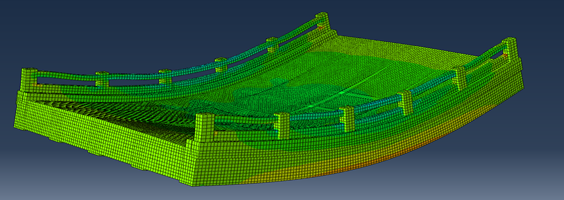
Project 1.01: Field Live Load Testing and Advanced Analysis of Concrete T-Beam
Field Live Load Testing and Advanced Analysis of Concrete T-Beam Bridges to Extend Service Life
Project 1.1
Project Summary
Concrete T-beam bridges are an important class of structures that has seen limited investigation. These structures are often perceived as quite robust and are in good condition, but possess very low rating factors based on conventional analysis per the AASHTO Manual for Bridge Evaluation. Testing of five T-beam bridges conducted in summer 2017 indicated that conventionally calculated rating factors are generally low for T-beam bridges. However, all of the tested bridges were un-skewed, and the effect of skew angle has not been quantified.
With support from the MaineDOT, UMaine personnel instrumented and field tested five cast-in-place, simple span, skewed concrete T-beam bridges. The specific structures tested were determined jointly by MaineDOT and UMaine engineers prior to the start of this project. The five T-beam bridges tested in summer 2018 were instrumented with a semi-wireless system using multiple strain gages located to assess both load distribution and flexural capacity. Girders were instrumented both at mid-span where moments will be at their maximum as well as near the supports to assess any unintended partial fixity.
To advance our understanding of the response of both skewed and un-skewed T-beam bridges, finite-element analyses of ten T-beam bridges are ongoing (Figure 1). Five of the bridges being modeled are the skewed bridges tested under this project, and the five un-skewed bridges tested in summer 2017 have been modeled. Initial finite-element models were three-dimensional and linearly elastic, employing solid (brick) elements to discretize the concrete components and embedded elements to represent the reinforcing. The models incorporated field-measured components including curbs, railings and integral wearing surfaces. Patch loads were applied that correspond to the measured truck wheel weights. Model validation was based on comparisons between model-predicted and measured strains for all ten structures. Novel, nonlinear finite-element models that permit the accurate inclusion of inherent ductility and a realistic assessment of capacity under the application of factored loads are also under development, and have been preliminarily validated. These models incorporate proxy finite-element analysis (PFEA), which was developed as part of this project. PFEA relies on coupling a straightforward, nonlinear moment-curvature analysis with a shell element, 3D discretization of the full bridge superstructure. Its advantages over conventional nonlinear 3D FEA include computational efficiency and PFEA’s reliance only on easily determined and well-defined concrete properties.
Project:
Completed
Start Date:
07/01/2018
End Date:
12/31/2019
Project Cost:
$95,992
Project Type:
Base Funded
Agency ID:
69A3551847101
Sponsors:
Maine Department of Transportation
Office of the Assistant Secretary for Research and Technology
Implementation of Research Outcomes:
This research has resulted in an increased understanding of the behavior of reinforced concrete T-beam bridge behavior through diagnostic live-load testing. In particular, it examined the differences between the behavior of skewed and unskewed structures and resulted in improved rating factors for a collection of five such structures. In addition, a method by which older, reinforced concrete bridge structures can be load-rated with a higher degree of accuracy than is available through conventional beam-line analysis. This method uses a novel finite element modeling technique to account for these structure’s considerable post-elastic capacity and ductility, resulting in increased rating factor over both conventional analysis and diagnostic live-load testing in most cases.
Impacts and Benefits of Implementation:
Improvement of the rating factors of five, older, reinforced concrete bridges has allowed the Maine Department of Transportation to remove them from the list of structures in need of remedial action (for instance load posting, repair, or replacement). This has allowed the Department to allocate scarce resources elsewhere and has mitigated potential costs to the general public due to construction and repair delays.
